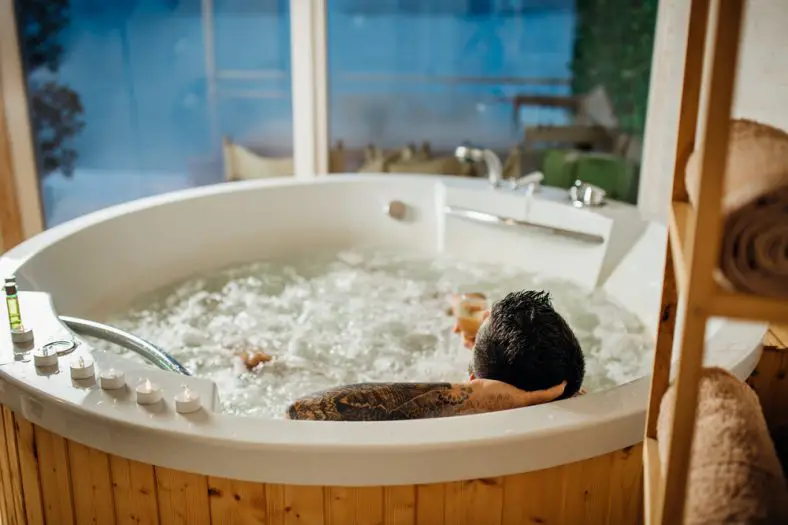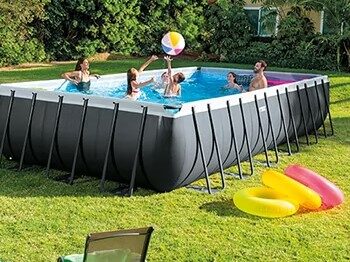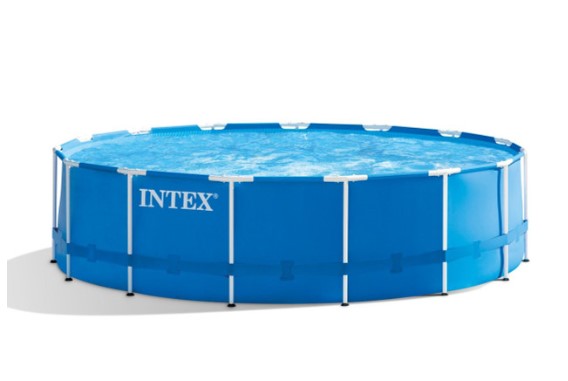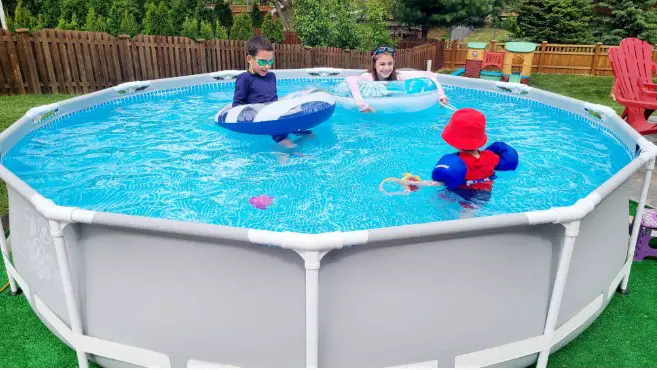Table of Contents
If you’re fortunate enough to have the luxury of a hot tub at home, your tub must be kept clean and bacteria-free.
If harmful bacteria and algae are left to grow, it can damage the function of your hot tub and potentially puts any user’s health at risk. To avoid this, chlorination is key.
Chlorine has been used for decades as a way to sanitize water. It effectively kills bacteria and prevents harmful build-up. In this article, we will explore the different chlorinators on the market right now. It can be difficult to know whether to opt for chlorine tablets or chlorine granules, read on to our Buyers’ Guide to help you make the right decision.
In a hurry?
If you’re looking to make a quick purchase and get back in the tub, then here is the quick list with links to our Top Picks!
Top 5 Best Chlorine for Hot Tubs
***OUR TOP PICK***
SpaGuard Chlorinating Concentrate

Our favorite hot tub chlorine on the market right now has to be SpaGuard Chlorinating Concentrate. This granulated stabilized chlorinator is great at keeping your hot tub bacteria-free and safe for you and your family.
It even acts as an oxidizer as well as a chlorinator, so you won’t have to go out and buy one separately. The fast-dissolving formula can be added straight to your hot tub with no pre-dissolving being necessary.
This product has thousands of positive reviews from happy customers who found it super easy to use and effective at preventing bacteria growth.
PROS:
- Granulated formulas are very effective
- Works as an oxidizer as well as a chlorinator
- Fast-dissolving formula
- User-friendly
- Thousands of positive reviews
CONS:
- It’s a little expensive for the amount that you get (2lbs)
EDITORS CHOICE
SpaChoice 472-3-5081 Chlorine Granules for Spas and Hot Tubs
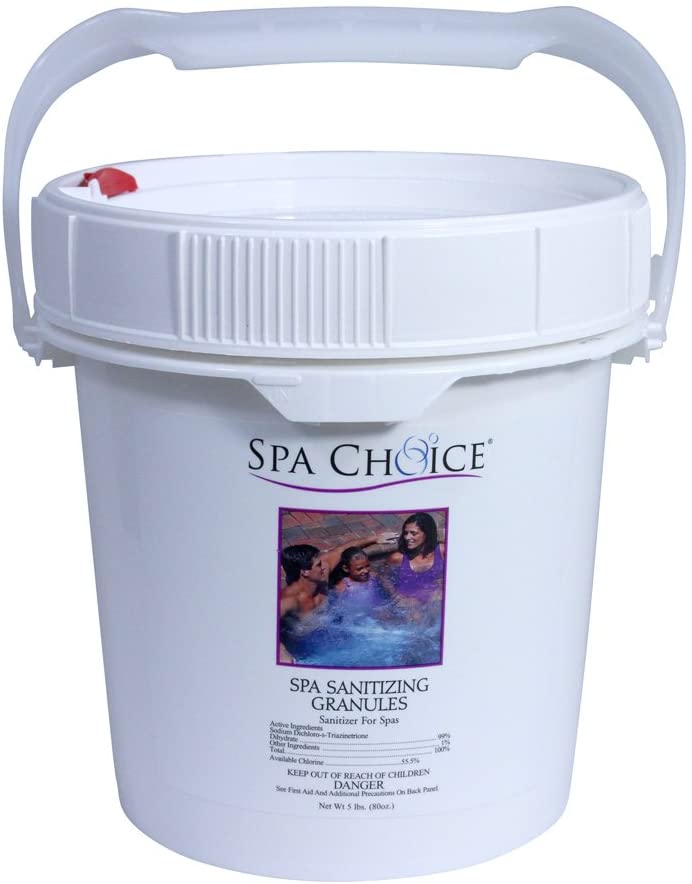
Next up is this impressive tub of chlorine granules from a brand called SpaChoice.
This product caught our eye due to its large size. It comes in a giant tub that weighs 5lbs, so you won’t find yourself constantly having to add chlorine to your shopping list. These granules are designed to dissolve quickly and completely.
They also claim to provide a steady source of available chlorine to spa water to control algae growth, kill bacteria, and destroy organic contaminants.
The SpaChoice chlorine granules are stabilized to protect against ultraviolet radiation from the sun, increasing the life of your chlorine.
PROS:
- Large 5lb tub won’t need constant re-stocking
- Quick-dissolve formula for easy use
- Effectively prevents bacteria and algae growth
- Ultraviolet protection means this chlorine lasts longer
CONS:
- Some reviewers found the child-proof tub difficult to open
BEST VALUE
LEISURE TIME 22337A Spa 56 Chlorinating Granules for Hot Tubs

We had to include these chlorinating granules for hot tubs made by Spa56.
Specially formulated for spas and hot tubs, this concentrated granular chlorine effectively sanitizes and shocks hot water to help keep it clean and clear.
These granules are even suitable for shock cleaning your hot tub, simply add 1oz of product per 500 gallons of water.
It’s also almost pH neutral, meaning it’s less likely to cause any itching or discomfort to those who use the hot tub.
PROS:
- Almost pH neutral making it less likely to cause side effects
- Effective cleaning power
- Suitable for shocking your hot tub
CONS:
- It’s quite expensive compared to other options
RUNNER UP
Kem-Tek 2815-6 Chlorinating Tablets 1-Inch Pool and Spa Chemicals
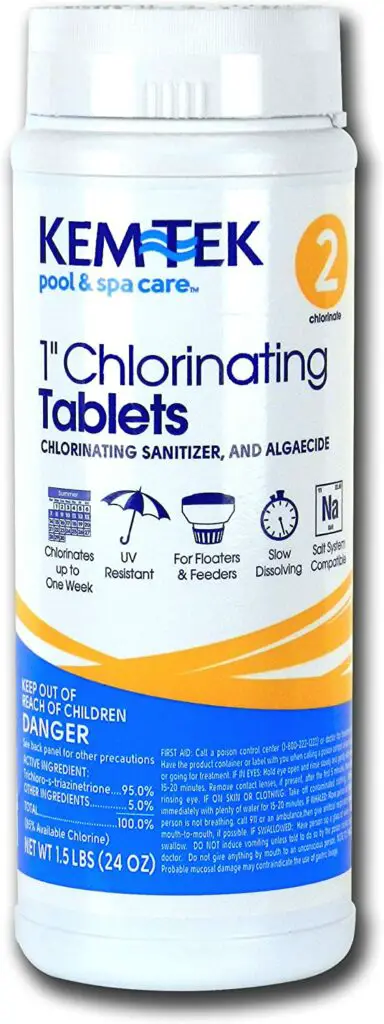
We wanted to include some chlorine tablets on this list as well as granules, so here are some chlorine tablets made by Kem-Tek.
The manufacturer claims that these tablets are suitable for every pool and hot tub.
You simply place them in a dispenser that floats in your hot tub. These slow-dissolving tablets are super-concentrated for long-lasting sanitation.
This bitesize 1.5lb tub makes it perfect for storing poolside so that you can maintain your hot tub is recommended.
PROS:
- The compact container makes it easy for carrying along or for storing near your tub
- The effective formula claims to prevent bacteria growth
- If maintained correctly, they can provide long-lasting protection
CONS:
- Chlorine tablets are acidic
RUNNER UP
Rx Clear 1-Inch Stabilized Chlorine Tablets
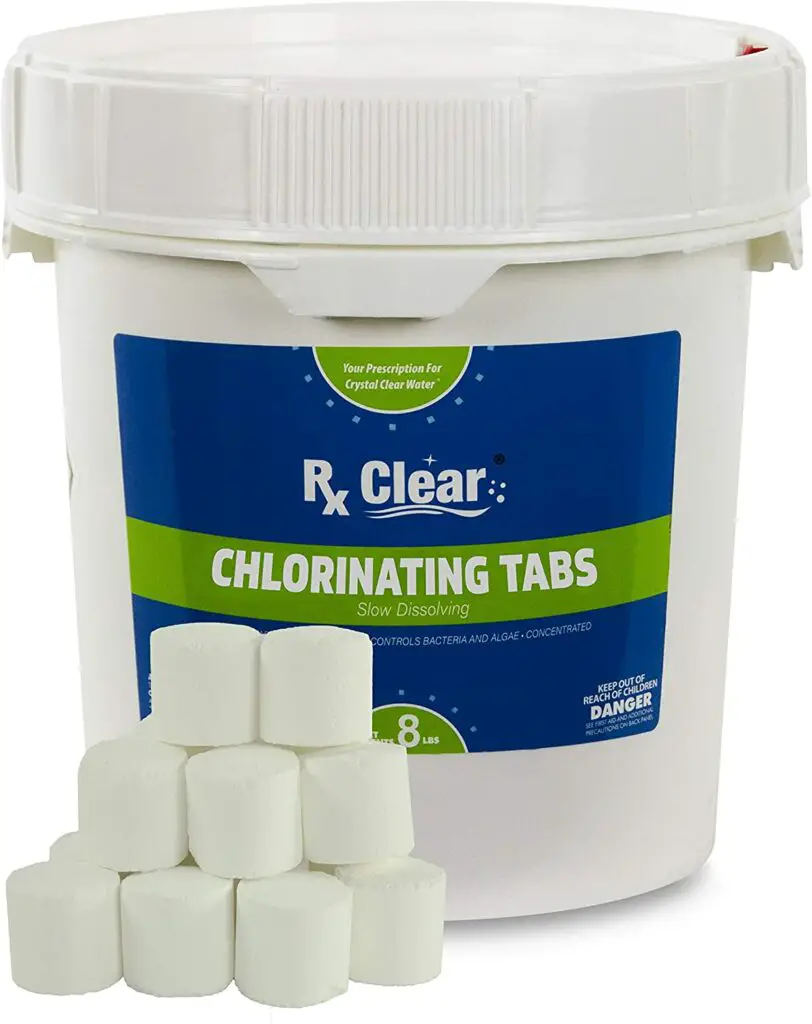
Last but certainly not least is this jumbo tub of chlorine tablets from Rx Clear. You simply use 16 ounces per 10,000 gallons of pool water per week.
This should be done by adding the pool chlorine tablets to your floating chlorinator or an inline/offline chlorinator and using the flow of your pump to dissolve and distribute the pool chemicals.
These Rx tablets are slow-dissolving for effective sanitation over time. The chlorine content in these tablets is also slightly higher than the average chlorine tablet.
Additionally, they are UV protected against the harmful sun rays, which prevents chlorine burn-off in your swimming pool and reduces the number of pool chemicals you need to add.
PROS:
- Huge selection of size options available
- Slow-dissolving tablets provide long-lasting protection
- Higher chlorine content than many other tablets
- UV ray protection
CONS:
- Tablets are more acidic than granules
- This is an expensive option
Best Chlorine for Hot Tub Buying Guide
When buying chlorine for your hot tub, you’ll probably notice that there are many different types to choose from.
The most popular types of hot tub chlorine you’ll typically come across are granules and tablets.
If you’re not experienced with hot tubs, it can be difficult to know what sort of chlorine to choose from and what features you should be looking for when shopping for some.
Here are a few things that we think you should consider before making a purchase.
Affordability
There isn’t much of a difference between the price of chlorine tablets and chlorine granules.
Chlorine granules used to be cheaper than tablets in the past, however, in recent years granules have become increasingly popular and therefore their price has increased.
Although they’re almost exactly as valuable as each other, tablets are just a tiny bit more affordable due to the hike in the price in recent years.
Ease of Use
If you’re going to be maintaining your hot tub yourself, it’s important that the chlorination process is user-friendly and fast. Fortunately, both chlorine granules and chlorine tablets are pretty easy to use.
Some people find that tablets are easier to use as you simply place one in a dispenser and just leave it to float around your tub.
While tablets require very little effort, it’s notoriously more difficult to boost overall chlorine levels with just tablets. In fact, some users like to add granules as well as tablets to boost chlorine levels.
Chlorine granules give the user more control than tablets do. With chlorine granules, you can adjust the exact amount that you want to dose.
Some people prefer this to slow-dissolving tablets. Both tablets and granules are fairly easy to use, it just comes down to personal preference.
Bacteria Control
Chlorine is great at controlling bacteria growth. The familiar scent may remind you of public swimming pools, but it’s an important addition to keep you and other users of your hot tub safe.
Both chlorine tablets and chlorine granules are very effective in killing bacteria.
It’s important to remember as a hot tub user that you must make sure that your chlorine level is between 3-5ppm. If the levels do not stay between these parameters, bacteria may be able to grow in the water.
The benefit of chlorine tablets is that the tablets slowly dissolve over time so therefore you have a supply of chlorine entering the water over a period. Chlorine granules must be added before use so there is a higher risk that levels might dip if the hot tub is not attended to. This adds to the risk of bacteria growth.
On the other hand, the appeal of chlorine tablets and the ‘fill the dispenser and leave it’ attitude does pose a risk that not enough chlorine is dissolved into the water and yet the user may assume that this is fine.
However, if this happens, bacteria may form without the user expecting it.
In terms of controlling the growth of bacteria, chlorine tablets and chlorine granules are just as effective as each other.
Instead, it comes down to the user and how well they’re able to maintain the chlorination of their hot tub.
We recommend checking your chlorine levels before every use and if you’re using it for long periods of time, check every hour or so.
Impact on User
Chlorine tablets are naturally acidic. In fact, their full name is Trichloroisocyanuric acid.
Due to their acidic nature, chlorine tablets slowly reduce the pH of the water and the alkaline levels.
If this isn’t dealt with straight away, some users of the hot tub may notice itchy skin or stingy eyes.
The other risk with chlorine tablets is their existence in a dispenser or skimmer in your hot tub; you must ensure that this is removed when the hot tub is in use to stop people from tampering with the tablets, as these can be harmful if not handled correctly.
Again, with chlorine granules dissolving instantly in your hot tub water, this issue does not exist.
Those who use chlorine granules don’t have to worry about this, as their pH is almost neutral. While proper care and attention should always be taken, chlorine granules are less likely to give you any water pH issues than chlorine tablets.
Impact on the Water
As mentioned above, the acidity of chlorine tablets can lower the overall pH balance of your hot tub water.
This fact has led many hot tub manufacturers throughout the United States to discourage users from putting chlorine tablets in their tubs.
Some companies even void the warranty if you use chlorine tablets instead of granules. This is probably due to the fact that tablets are considered an easy option, so some users may toss in a handful of tablets and just assume that’s enough.
However, this will soon cause the pH levels to plummet which in turn can lead to itchy skin and a burning sensation in and around the eyes.
As well as having an impact on the user, low pH levels can affect the overall effectiveness of your hot tub. With PH being potentially very low as a result of the chlorine tablets, there is a risk that the chlorine cannot effectively kill bacteria, which could also put users at further risk.
Frequently Asked Questions
How much chlorine should I put in my hot tub?
In a hot tub, chlorine should be maintained at a level of 1 to 3 parts per million (ppm). For hot tubs, only about a capful of chlorine is required to deliver a 1 to 3 ppm-level.
A pH range of 7.2 to 7.8 is ideal for a hot tub, and the granular chlorine in it will be at its most effective. The pH levels in a hot tub that are below 7.2 will begin causing chlorine to disappear. A hot tub pH level above 7.8 causes available chlorine to work very sluggishly.
Can I use bleach in my hot tub instead of chlorine?
You never want to use bleach in place or regular chlorine or bromine sanitizing, but you can use bleach to occasionally shock your hot tub water and use diluted bleach to clean the shell of an empty hot tub.
Just avoid using liquid chlorine designed for swimming pools. The shock helps get rid of any nasty stuff that the regular treatment with chlorine or bromine doesn’t get rid of; algae, viruses, bacteria, etc.
But shocking also gets rid of bromides which are a compound created when bromine degrades.
Bromides are bad for a few reasons but most importantly because they show up on your test strips as bromine does, but they don’t protect you from contaminants as bromine does.

